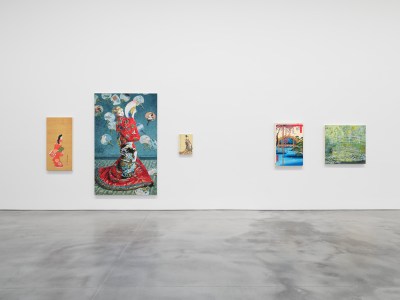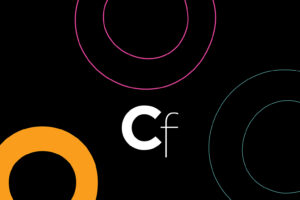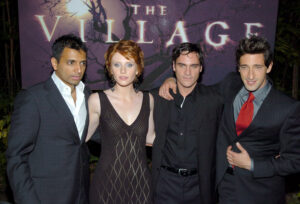Takashi Murakami’s Serious Side

“Is that a real Monet?” asks a visitor to Takashi Murakami’s new exhibition at Gagosian New York, “JAPONISME → Cognitive Revolution: Learning from Hiroshige,” on view through July 11. The Japanese artist has subjected the French Impressionist to his characteristic screen-printing technique in Claude Monet’s “Water Lily Pond” And Me, Submerged in the Pond Like Gollum (2025), a slick copy that from a squinting distance might fool you. Conveniently, squinting distance is a popular suggestion for the best way to view Impressionism. Murakami knows his audience; he knows they are always looking at and through screens, and that the lure of the apparently famous now pulls harder than the onetime aura of originality.
The same fate has befallen Murakami himself, known more as a celebrity figure than a serious artist. But both his skill and his knowledge of art history, which includes a PhD in traditional Japanese painting, are evident in this exhibition. Despite appearances (and the inclusion of several examples of his Louis Vuitton monogram canvases, allusions to the artist’s collaboration with luxury brands), this show seems less about outward attraction and more about inward exploration. The bulk of the work comes from Murakami’s take on Hiroshige’s 100 Famous Views of Edo (1856–58), a series that began with his 2024 show at the Brooklyn Museum (which houses a set of Hiroshige’s prints). Murakami scaled up the prints to made them into immersive canvases, adding glitter and some of his signature characters to create a “spot the difference” effect, but he was essentially devoted to retracing one of the great treasures of Japanese culture. Copying, in this instance, is a form of reverence and even inheritance: Muarakami has described using the copies to understand his place within the history of art, claiming in an interview with ARTnews that “maybe I wasn’t outside the story—I just hadn’t seen how the thread connected yet.”

View of Takashi Murakami’s exhibition “JAPONISME → Cognitive Revolution: Learning from Hiroshige,” 2025, at Gagosian, New York.
Photo Kei Okano. Courtesy the artist and Gagosian. ©Takashi Murakami/Kaikai Kiki Co., Ltd.
That story isn’t limited to the art of Japan. What’s new here is Murakami’s copying of European artists including Monet, who were themselves drawing on Japanese influences—what was termed “Japonisme” by the nineteenth-century French critic Philip Burty. Like Murakami’s own aesthetic, Superflat, which can be traced to the decimation of Japan’s economy post-WWII, Japonisme came in the wake of Western aggression against the formerly closed state. By the 1860s, gunboat diplomacy resulted in asymmetrical treaties that forced Japan to engage in unfavorable trade with the West and that prompted an influx of Japanese art, which appeared radical to European eyes.
Artists newly exposed to Japanese prints including Hiroshige’s adopted the flat planes of strong color, vertical orientation, and emphasis on patterning that they observed in Japanese art as they worked to develop a mode of modern painting. Recognizing a fresh sense of truthfulness in this Japanese influence—one based in the essence of things, rather than an illusionistic imitation—brought another critic, Théodore Duret, to declare “Before Japan it was impossible; the painter always lied.”

View of Takashi Murakami’s exhibition “JAPONISME → Cognitive Revolution: Learning from Hiroshige,” 2025, at Gagosian, New York.
Photo Kei Okano. Courtesy the artist and Gagosian. ©Takashi Murakami/Kaikai Kiki Co., Ltd.
What truth is at stake in this new iteration of Japonisme? At a time when cultural borrowings are more likely to be condemned as appropriation, Murakami seems to be intervening in a debate about who has the right to copy whom. The Japonaise of Claude Monet’s “La Japonaise” (2025) takes on Monet’s 1876 portrait of his wife Camille dressed up in a kimono. (The Monet was the subject of controversy in 2015 when the Museum of Fine Arts Boston exhibited it alongside a kimono visitors were invited to try on, as if identity can be assumed and dropped like a garment.) In addition to Monet’s copied signature, Murakami added his own in conspicuous Latin script in what may be a gesture of reclamation but one that also implicitly undersigns the initial borrowing. He similarly recreates the cover of a French illustrated magazine dedicated to Japan (Fig. 2 Paris Illustré Cover of the May 1, 1886 issue Butterfly, 2025), featuring a reproduction of a print of a Japanese geisha. Van Gogh (whose work Murakami also copies for the show) had traced the woman’s body from that same cover in 1887, aligning Murakami with a mode of modern art that made liberal use of whatever was available to it.
Still, cultural borrowings have consequences, including potentially transforming the actual people who make up those cultures into consumable motifs. Murakami may allude to these consequences in his inclusion of UFOs in several of the copied works: a small vessel floats above the bridge in James McNeill Whistler’s “Nocturne: Blue and Gold – Old Battersea Bridge” Then a UFO Flew By (2025). Beyond introducing an element of surprising strangeness, the UFOs invoke current issues around so-called “illegal” aliens, asking what aspects of other cultures we are willing to accept and what degree of difference is tolerated. A more searing response is on view at the Metropolitan Museum of Art in New York as part of “Monstrous Beauty,” a superbly curated show on “chinoiserie,” another instance of Europeans drawing influence from Asian cultures. At the end of a series of galleries showing Asian women’s bodies adorning everything from teacups to mirrors, Patty Chang’s Abyssal (2025), a porcelain massage table shot through with holes referencing the 2021 Atlanta spa massacre, makes those bodies real, and renders their appropriation a deadly serious matter.






